|
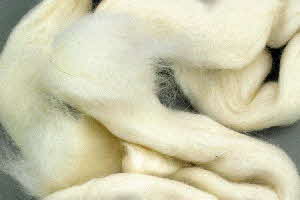 Angora rabbit Angora rabbit
The Angora rabbit originated in Turkey and the name is derived from the city of Ankara in Turkey according to Wikipedia. Angora rabbit fibre production is the third largest animal fibre industry in the world (10,000 tons p.a.), with only wool and mohair being larger. The production of Angora is then followed by cashmere and alpaca.
Angora Rabbits are farmed throughout the world but China is the world's leading producer of Angora rabbit hair, contributing approximately 90 percent of world production, and Chile is the second largest producer.
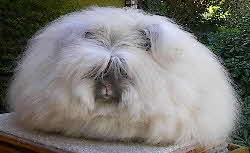 Farming of angora rabbits is not always animal-friendly. They are often farmed in intensive factory farms in China and may be plucked, rather than sheared, to ensure long fibre length for spinning purposes. Humane alternatives exist, however, where rabbits are not kept in small cages and are able to run around and burrow. The rabbits live a natural life and are scissor-sheared with no stress. Farming of angora rabbits is not always animal-friendly. They are often farmed in intensive factory farms in China and may be plucked, rather than sheared, to ensure long fibre length for spinning purposes. Humane alternatives exist, however, where rabbits are not kept in small cages and are able to run around and burrow. The rabbits live a natural life and are scissor-sheared with no stress.
There are 2 types of hair, 10 cm long coarse guard hairs of 30-40 microns and shorter fine down hairs around 15 microns that are 50 times more numerous than the guard hairs. An Angora rabbit typically produces 1 kg of fine down fibre over 4 harvests per year (EFFN).
The Angora fibre has a smooth, silky texture making it difficult to spin but the hair is fine and soft. It is warm, lightweight and can have a pure white colour.
Top of page
Mohair and Angora goats
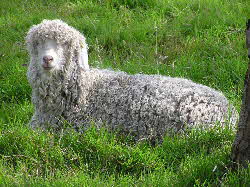 Mohair is the fabric or yarn made from the hair of the Angora goat and is one of the warmest natural fibres and one of the most versatile. Mohair is the fabric or yarn made from the hair of the Angora goat and is one of the warmest natural fibres and one of the most versatile.
The word "mohair" was adopted into English before 1570 from the Arabic mukhayyar, a type of haircloth. The Angora goat is thought to have originated from the mountains of Tibet making their way to Turkey by the 16th century. South Africa currently produces more than 60 percent of the total world production of mohair of 5 million kg per year.
The fibres range from 23 microns in mean diameter at the first shearing up to 38 microns in older animals. The range of uses of mohair fibre is a result of the range of diameter of the fibre produced. Mohair from young goats is used for finer applications such as clothing and the thicker hair from older animals is more often used for carpets and coats.
Angora goats produce 3-4 kg of mohair fibre per year and are shorn twice per year in Europe, in spring and autumn. These goats have a single coat but may sometimes have some kemp fibres in the coat.
Mohair is both durable and resilient. It is notable for its high lustre and sheen, and is often used in fibre blends to add these qualities to other textiles. Mohair takes dye exceptionally well and has good insulating properties, making it warm. It is also moisture-wicking, stretch and flame resistant, and crease resistant.
Top of page
Cashmere
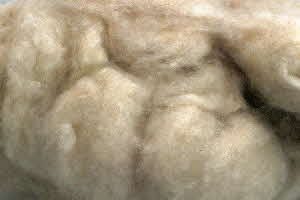
The Cashmere and Camel Hair Manufacturers Institute (CMMI) defines cashmere as the fine (dehaired) undercoat fibres produced by a cashmere goat (Capra hircus laniger) and that the fibre should have a mean maximum diameter of 19 microns.
The cashmere goat is an Asiatic domestic goat that has been bred to produce cashmere fibre. All goats (except for Angora goats) produce two coats of fibre: an outer, coarse coat of guard hairs and a second fine, downy undercoat that grows and is shed seasonally. When that down coat is less than 19 microns in diameter, is low in lustre and has a good crimp, it is considered to be cashmere. The fibers that are considered cashmere make cashmere sweaters and other fine accessories.
World production is about 16,000 tons with China producing 60% of the total and other Asian countries most of the remainder. Individual goats produce from 50-300 gm per year, and this is obtained by shearing before, or combing during, the spring moult.
The double coat is formed of a guard coat of coarse, long hairs of 30-100 micron in diameter and 6-20 cm in length, and a fine, inner coat of down hairs 12-18 microns diameter and 4-8 cm in length.
Top of page
Yak
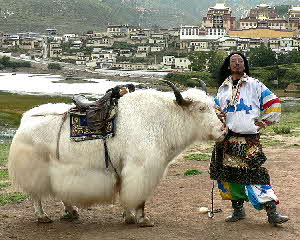 The yak (Bos grunniens) thrives in extreme conditions while providing a livelihood for people. It is a herbivore and lives predominantly on the Qinghai-Tibetan Plateau or "Roof of the World”. At this high elevation, the plateau has a harsh climate of cool moist summers, severely cold winters and grazing restricted by short growing seasons. More than 13 million yaks live and provide food, transport, shelter and fuel where few other animals will survive (FAO). The yak (Bos grunniens) thrives in extreme conditions while providing a livelihood for people. It is a herbivore and lives predominantly on the Qinghai-Tibetan Plateau or "Roof of the World”. At this high elevation, the plateau has a harsh climate of cool moist summers, severely cold winters and grazing restricted by short growing seasons. More than 13 million yaks live and provide food, transport, shelter and fuel where few other animals will survive (FAO).
Yaks are kept mainly for milk, meat and hide in China and Tibet but increasingly for fibre.
Yaks produce two types of fibre: coarse outer hair and a fine down fibre that grows before the onset of winter as additional protection against cold. The down fibre is shed in early summer if not harvested and shedding is greatest from the belly of the yak and less from the back and rump (see photo).
The down has, however, been used extensively by the textile industry as an alternative to other fine animal fibres since the 1970s. It is both combed and shorn to increase yield. Fabric made from yak down has a better lustre than wool and provides a high degree of heat insulation.
Some yak (Jiulong) produce as much as 25 kg fibre, of which 50 percent is down fibre. This is ten times the yield of most ordinary yak. Typically the down fibres are around 20 microns in size whilst the coarse outer hairs are 75-90 microns (FAO).
- Wool from sheep
- Fibre sizes and choosing fibre
- History of sheep and wool
- Sheep breeds
Top of Page
|

